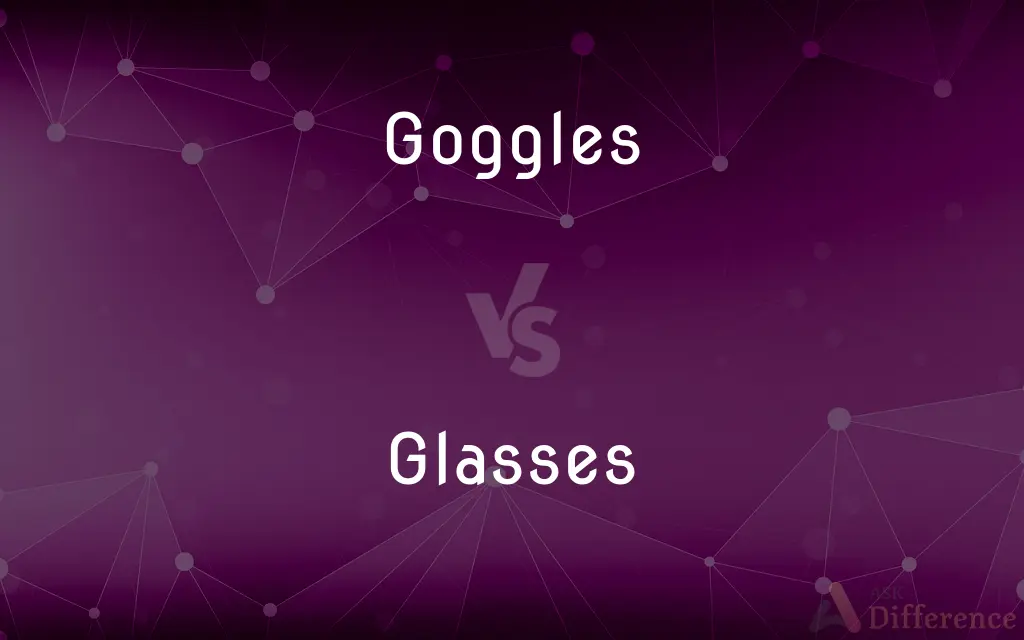Goggles vs. Glasses — What's the Difference?
By Maham Liaqat & Fiza Rafique — Updated on March 21, 2024
Goggles protect against environmental factors with a secure seal, while glasses correct vision or protect eyes with minimal coverage.

Difference Between Goggles and Glasses
Table of Contents
ADVERTISEMENT
Key Differences
Goggles are designed to fit securely around the eye area, providing protection against dust, water, wind, and chemicals, whereas glasses typically consist of two lenses set in a frame that rests on the nose and ears, offering vision correction or minimal eye protection.
Goggles offer a seal around the eyes to prevent entry of harmful substances or materials, while glasses are more focused on correcting vision or shielding the eyes from sunlight without a sealed fit. Goggles are often used in industrial, laboratory, or extreme sports settings for enhanced safety, whereas glasses are commonly worn daily for vision correction or as a fashion accessory.
While goggles are essential for specific safety or environmental needs, glasses serve a broader range of purposes, including vision correction, sun protection, and style. Goggles are crucial in environments where eye safety is a priority, offering a sealed barrier against hazardous materials, whereas glasses provide a basic level of protection against UV light or improve vision.
Goggles often come with features like anti-fog lenses and are made from durable materials to withstand harsh conditions, while glasses focus on lightweight design and optical clarity. Goggles are mandatory in certain workplaces and sports to prevent eye injuries, while glasses can be optional and chosen for their aesthetic or corrective properties.
The choice between goggles and glasses depends on the specific needs of the wearer, whether it's for protection in hazardous environments or for everyday use in correcting vision or blocking UV rays.
ADVERTISEMENT
Comparison Chart
Primary Use
Protection against environmental factors
Vision correction or eye protection
Fit
Secure seal around the eyes
Rest on the nose and ears
Protection Level
High, against dust, chemicals, water, and impact
Moderate, against UV light and minor impacts
Common Materials
Polycarbonate, silicone, rubber
Plastic, metal, polycarbonate
Typical Environments
Industrial, laboratory, extreme sports
Daily wear, outdoor, office
Compare with Definitions
Goggles
Protective Eyewear
The scientist wore goggles to protect her eyes from chemical splashes.
Glasses
Vision Correction
She wears glasses to correct her nearsightedness.
Goggles
Sealed Fit
Swimming goggles create a watertight seal to prevent water from blurring vision.
Glasses
Fashion Accessory
His glasses add a sophisticated touch to his outfit.
Goggles
Specialized Features
Ski goggles have anti-fog coatings for clear vision on the slopes.
Glasses
Lightweight Design
Modern glasses are designed to be comfortable and lightweight for all-day wear.
Goggles
Safety Compliance
Safety goggles must meet specific standards to be used in laboratories.
Glasses
Sun Protection
Sunglasses protect the eyes from harmful UV rays during sunny days.
Goggles
Diverse Environments
Construction workers use goggles to shield their eyes from dust and debris.
Glasses
Optical Clarity
Prescription glasses provide clear vision, enhancing daily activities.
Goggles
Goggles, or safety glasses, are forms of protective eyewear that usually enclose or protect the area surrounding the eye in order to prevent particulates, water or chemicals from striking the eyes. They are used in chemistry laboratories and in woodworking.
Glasses
Glasses, also known as eyeglasses or spectacles, are vision eyewear, consisting of glass or hard plastic lenses mounted in a frame that holds them in front of a person's eyes, typically utilizing a bridge over the nose and hinged arms (known as temples or temple pieces) which rest over the ears. Glasses are typically used for vision correction, such as with reading glasses and glasses used for nearsightedness, however, without the specialized lenses, they are sometimes used for cosmetic purposes.
Goggles
To stare with wide and bulging eyes.
Glasses
A pair of lenses set in a frame resting on the nose and ears, used to correct or assist defective eyesight.
Goggles
To roll or bulge. Used of the eyes.
Glasses
Any of a large class of materials with highly variable mechanical and optical properties that solidify from the molten state without crystallization, are typically made by silicates fusing with boric oxide, aluminum oxide, or phosphorus pentoxide, are generally hard, brittle, and transparent or translucent, and are considered to be supercooled liquids rather than true solids.
Goggles
To roll or bulge (the eyes).
Glasses
A drinking vessel.
Goggles
A stare or leer.
Glasses
A mirror.
Goggles
GogglesA pair of tight-fitting eyeglasses, often tinted or having side shields, worn to protect the eyes from hazards such as wind, glare, water, or flying debris.
Glasses
A barometer.
Goggles
Protective eyewear set in a flexible frame to fit snugly against the face.
Goggles must be worn in the swimming pool.
We had to put on our goggles as it was snowing outside.
Glasses
A window or windowpane.
Goggles
Blinds for shying horses.
Glasses
The series of transparent plastic sheets that are secured vertically above the boards in many ice rinks.
Goggles
Spectacles worn to protect the eyes
Glasses
Glasses A pair of lenses mounted in a light frame, used to correct faulty vision or protect the eyes.
Glasses
Often glasses A binocular or field glass.
Glasses
A device, such as a monocle or spyglass, containing a lens or lenses and used as an aid to vision.
Glasses
The quantity contained by a drinking vessel; a glassful.
Glasses
Objects made of glass; glassware.
Glasses
Made or consisting of glass.
Glasses
Fitted with panes of glass; glazed.
Glasses
To enclose or encase with glass.
Glasses
To put into a glass container.
Glasses
To provide with glass or glass parts.
Glasses
To make glassy; glaze.
Glasses
To see reflected, as in a mirror.
Glasses
To reflect.
Glasses
To scan (a tract of land or forest, for example) with an optical instrument.
Glasses
To become glassy.
Glasses
To use an optical instrument, as in looking for game.
Glasses
Plural of glass
Glasses
Spectacles, frames bearing two lenses worn in front of the eyes.
Glasses
Field glasses; binoculars.
Glasses
Same as eyeglasses. See eyeglass{1}.
Glasses
Optical instrument consisting of a pair of lenses for correcting defective vision
Common Curiosities
Are goggles comfortable for daily wear?
While goggles provide excellent protection, they may not be as comfortable for daily wear as glasses.
Can glasses protect eyes like goggles?
Glasses provide minimal protection compared to goggles, which offer a secure seal against environmental factors.
Are there glasses that offer protection similar to goggles?
Some glasses are designed with safety features, but they typically do not offer the same level of protection as goggles.
Can I wear glasses under goggles?
Yes, there are specially designed goggles that can be worn over glasses.
What are goggles used for?
Goggles are used for eye protection in hazardous environments, preventing entry of harmful materials.
Do goggles come in different sizes?
Yes, goggles are available in various sizes to ensure a proper and secure fit for different face shapes.
Can glasses correct all types of vision problems?
Glasses can correct many common vision problems, such as nearsightedness, farsightedness, and astigmatism.
How should goggles fit?
Goggles should fit snugly around the eyes and face without causing discomfort or impairing vision.
Are there goggles that can be used for swimming and skiing?
While there are goggles designed for specific activities, swimming and skiing goggles are usually designed differently to suit each environment's specific needs.
What materials are goggles made from?
Goggles are usually made from durable materials like polycarbonate, silicone, or rubber.
Can wearing glasses slow the progression of vision problems?
Glasses correct vision but do not generally slow the progression of vision problems.
How often should glasses be replaced?
Glasses should be replaced as needed based on prescription changes or wear and tear.
How do I clean my goggles?
Goggles should be cleaned according to the manufacturer's instructions, typically with mild soap and water.
Why are goggles important in sports?
Goggles provide crucial eye protection in sports where there is a risk of eye injury.
Are there prescription goggles?
Yes, prescription goggles are available for those who need vision correction in environments where goggles are required.
Share Your Discovery

Previous Comparison
Democracy vs. Bureaucracy
Next Comparison
Implement vs. DeployAuthor Spotlight
Written by
Maham LiaqatCo-written by
Fiza RafiqueFiza Rafique is a skilled content writer at AskDifference.com, where she meticulously refines and enhances written pieces. Drawing from her vast editorial expertise, Fiza ensures clarity, accuracy, and precision in every article. Passionate about language, she continually seeks to elevate the quality of content for readers worldwide.















































